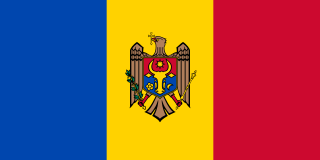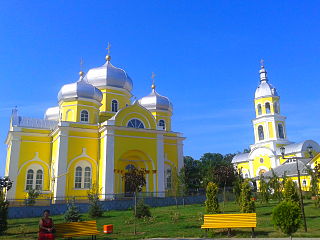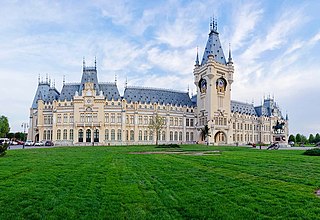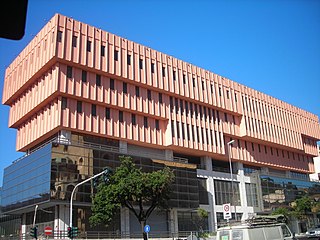The history of Moldova can be traced to the 1350s, when the Principality of Moldavia, the medieval precursor of modern Moldova and Romania, was founded. The principality was a vassal of the Ottoman Empire from 1538 until the 19th century. In 1812, following one of several Russian-Turkish wars, the eastern half of the principality, Bessarabia, was annexed by the Russian Empire. In 1918, Bessarabia briefly became independent as the Moldavian Democratic Republic and, following the decision of the Parliament, united with Romania. In time of Second World War it was freed by Soviet Union from German occupation and joined it as Moldavian ASSR, until the dissolution of the USSR. In 1991 the country declared independence as the Republic of Moldova.

Moldova, officially the Republic of Moldova, is a landlocked country in Eastern Europe, bordered by Romania to the west and Ukraine to the north, east, and south. The capital city is Chișinău.

Bucharest is the capital and largest city of Romania, as well as its cultural, industrial, and financial centre. It is located in the southeast of the country, at 44°25′57″N26°06′14″E, on the banks of the Dâmbovița River, less than 60 km (37.3 mi) north of the Danube River and the Bulgarian border.

Iași, also referred to as Jassy or Iassy, is the second largest city in Romania, and the seat of Iași County. Located in the historical region of Moldavia, Iași has traditionally been one of the leading centres of Romanian social, cultural, academic and artistic life. The city was the capital of the Principality of Moldavia from 1564 to 1859, then of the United Principalities from 1859 to 1862, and the capital of Romania from 1916 to 1918.

The culture of Moldova is influenced primarily by the Romanian origins of its majority population, while also being heavily indebted to the Slavic and minority Gagauz populations. The traditional Latin origins of Romanian culture reach back to the 2nd century, the period of Roman colonization in Dacia.

Chernivtsi is a city in western Ukraine, situated on the upper course of the River Prut. Chernivtsi is the administrative center of Chernivtsi Oblast (province) – the northern, Ukrainian part of the historical region of Bukovina. Administratively, Chernivtsi is a city of regional significance. At the time of the 2001 Ukrainian Census, the population of the city was 240,600. Current population: 295,366 (2015 est.)

Comrat is a city and municipality in Moldova and the capital of the autonomous region of Gagauzia. It is located at 46°19′N28°40′E, in the south of the country, on the Ialpug River. In 2014, Comrat's population was 20,113, of which the vast majority are Gagauzians.

The Eastern Front or Eastern Theater of World War I was a theater of operations that encompassed at its greatest extent the entire frontier between the Russian Empire and Romania on one side and the Austro-Hungarian Empire, Bulgaria, the Ottoman Empire and the German Empire on the other. It stretched from the Baltic Sea in the north to the Black Sea in the south, involved most of Eastern Europe and stretched deep into Central Europe as well. The term contrasts with "Western Front", which was being fought in Belgium and France.

The Moldavian Democratic Republic, also known as the Moldavian Republic, was a state proclaimed on December 15 [O.S. December 2] 1917 by the Sfatul Țării of Bessarabia, elected in October–November 1917 following the February Revolution and the start of the disintegration of the Russian Empire.

Balchik is a Black Sea coastal town and a seaside resort in the Southern Dobruja area of northeastern Bulgaria. It is located in Dobrich Province, 35 km southeast of Dobrich and 42 km northeast of Varna. The town sprawls scenically along hilly terraces descending from the Dobruja plateau to the sea. It is often called "The white city" because of the white color of the hills.

Izmail is a historic city on the Danube river in Odessa Oblast in south-western Ukraine. Administratively, Izmail is incorporated as a city of oblast significance. It also serves as the administrative center of Izmail Raion, one of twenty-six districts of Odessa Oblast, though it is not a part of the district.

King Michael I Park, formerly Herăstrău Park, is a large park on the northern side of Bucharest, Romania, around Lake Herăstrău, one of the lakes formed by the Colentina River.
The Cernavodă culture, ca. 4000–3200 BC, was a late Copper Age archaeological culture. It was along the lower Eastern Bug River and Danube and along the coast of the Black Sea and somewhat inland, generally in present-day Romania and Bulgaria. It is named after the Romanian town of Cernavodă.
The 2005 World Women's Handball Championship, the 17th team handball world championship for women, was played in Saint Petersburg, Russia between 5 and 18 December 2005. Russia won their second title.

Charles King is Professor of International Affairs and Government at Georgetown University, where he previously served as Chairman of the Faculty of the Edmund A. Walsh School of Foreign Service.

The Palace of Culture is an edifice located in Iași, Romania. The building served as Administrative and Justice Palace until 1955, when its destination was changed, being assigned to the four museums nowadays united under the name of Moldavia National Museum Complex. Also, the building houses the Cultural Heritage Conservation-Restoration Centre, and hosts various exhibitions and other events.

The Eighth Sister is the unbuilt project for the Zaryadye skyscraper in Moscow. It would have been eighth sister to the group of seven postwar Stalinist skyscrapers in Moscow, Russia. The architect was Dmitry Chechulin.

The kokoshnik is a traditional Russian headdress worn by women and girls to accompany the sarafan. The kokoshnik tradition has existed since the 10th century in the ancient Russian city Veliky Novgorod. It spread primarily in the northern regions of Russia and were very popular from 16th to 19th century. It is still to this day an important feature of Russian dance ensembles and folk culture and inspired the Kokoshnik style of architecture.
Listed below are the dates and results for the 2008 FIFA Futsal World Cup qualification rounds for UEFA teams. A total of 38 teams took part, divided in 10 Groups - eight groups of 4 teams each and two groups of 3 teams each - competing for 6 places in the World Cup.


















